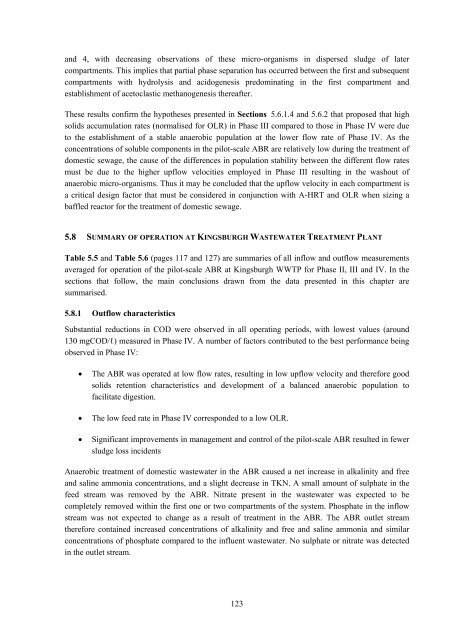analysis of a pilot-scale anaerobic baffled reactor treating domestic ...
analysis of a pilot-scale anaerobic baffled reactor treating domestic ...
analysis of a pilot-scale anaerobic baffled reactor treating domestic ...
You also want an ePaper? Increase the reach of your titles
YUMPU automatically turns print PDFs into web optimized ePapers that Google loves.
and 4, with decreasing observations <strong>of</strong> these micro-organisms in dispersed sludge <strong>of</strong> later<br />
compartments. This implies that partial phase separation has occurred between the first and subsequent<br />
compartments with hydrolysis and acidogenesis predominating in the first compartment and<br />
establishment <strong>of</strong> acetoclastic methanogenesis thereafter.<br />
These results confirm the hypotheses presented in Sections 5.6.1.4 and 5.6.2 that proposed that high<br />
solids accumulation rates (normalised for OLR) in Phase III compared to those in Phase IV were due<br />
to the establishment <strong>of</strong> a stable <strong>anaerobic</strong> population at the lower flow rate <strong>of</strong> Phase IV. As the<br />
concentrations <strong>of</strong> soluble components in the <strong>pilot</strong>-<strong>scale</strong> ABR are relatively low during the treatment <strong>of</strong><br />
<strong>domestic</strong> sewage, the cause <strong>of</strong> the differences in population stability between the different flow rates<br />
must be due to the higher upflow velocities employed in Phase III resulting in the washout <strong>of</strong><br />
<strong>anaerobic</strong> micro-organisms. Thus it may be concluded that the upflow velocity in each compartment is<br />
a critical design factor that must be considered in conjunction with A-HRT and OLR when sizing a<br />
<strong>baffled</strong> <strong>reactor</strong> for the treatment <strong>of</strong> <strong>domestic</strong> sewage.<br />
5.8 SUMMARY OF OPERATION AT KINGSBURGH WASTEWATER TREATMENT PLANT<br />
Table 5.5 and Table 5.6 (pages 117 and 127) are summaries <strong>of</strong> all inflow and outflow measurements<br />
averaged for operation <strong>of</strong> the <strong>pilot</strong>-<strong>scale</strong> ABR at Kingsburgh WWTP for Phase II, III and IV. In the<br />
sections that follow, the main conclusions drawn from the data presented in this chapter are<br />
summarised.<br />
5.8.1 Outflow characteristics<br />
Substantial reductions in COD were observed in all operating periods, with lowest values (around<br />
130 mgCOD/ℓ) measured in Phase IV. A number <strong>of</strong> factors contributed to the best performance being<br />
observed in Phase IV:<br />
• The ABR was operated at low flow rates, resulting in low upflow velocity and therefore good<br />
solids retention characteristics and development <strong>of</strong> a balanced <strong>anaerobic</strong> population to<br />
facilitate digestion.<br />
• The low feed rate in Phase IV corresponded to a low OLR.<br />
• Significant improvements in management and control <strong>of</strong> the <strong>pilot</strong>-<strong>scale</strong> ABR resulted in fewer<br />
sludge loss incidents<br />
Anaerobic treatment <strong>of</strong> <strong>domestic</strong> wastewater in the ABR caused a net increase in alkalinity and free<br />
and saline ammonia concentrations, and a slight decrease in TKN. A small amount <strong>of</strong> sulphate in the<br />
feed stream was removed by the ABR. Nitrate present in the wastewater was expected to be<br />
completely removed within the first one or two compartments <strong>of</strong> the system. Phosphate in the inflow<br />
stream was not expected to change as a result <strong>of</strong> treatment in the ABR. The ABR outlet stream<br />
therefore contained increased concentrations <strong>of</strong> alkalinity and free and saline ammonia and similar<br />
concentrations <strong>of</strong> phosphate compared to the influent wastewater. No sulphate or nitrate was detected<br />
in the outlet stream.<br />
123
















